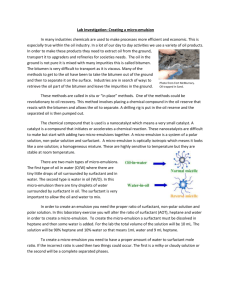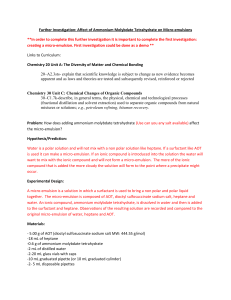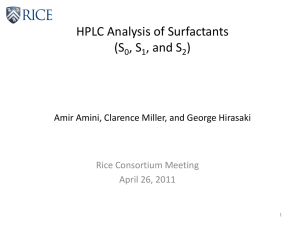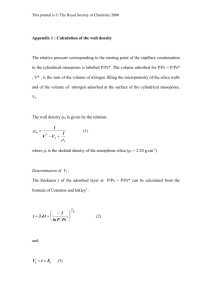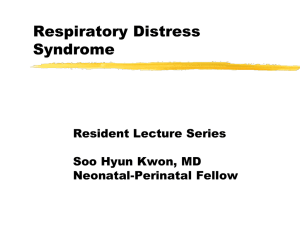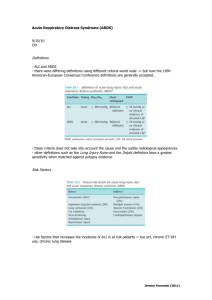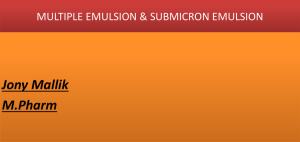Lab Investigation: Creating Micro-emulsions TR
advertisement
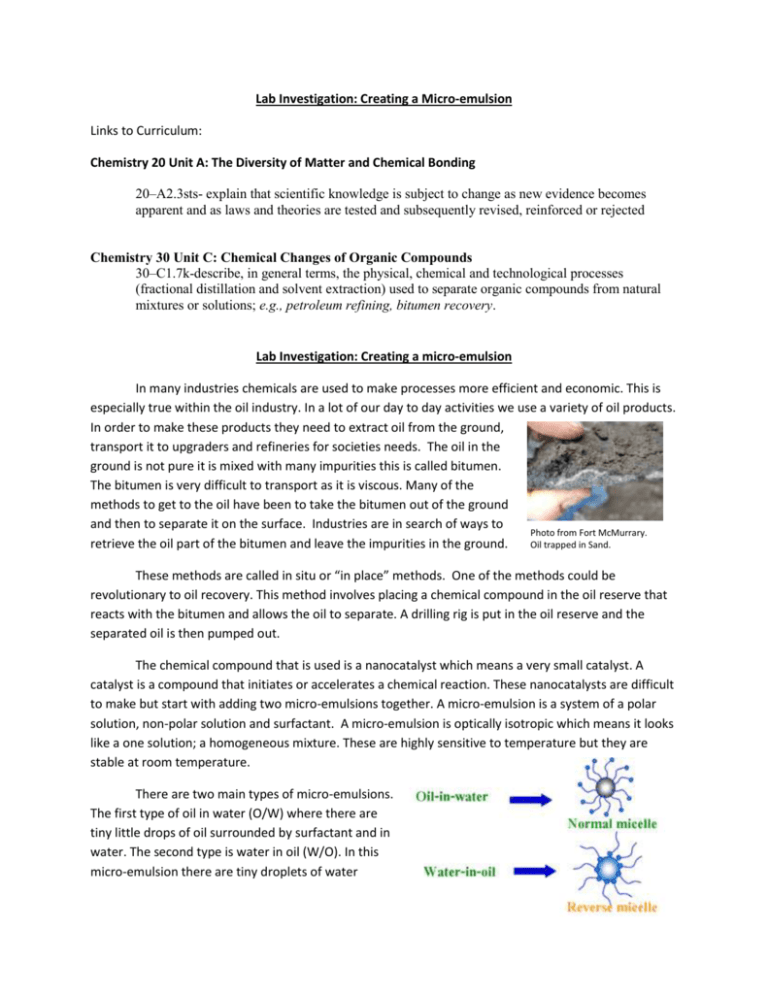
Lab Investigation: Creating a Micro-emulsion Links to Curriculum: Chemistry 20 Unit A: The Diversity of Matter and Chemical Bonding 20–A2.3sts- explain that scientific knowledge is subject to change as new evidence becomes apparent and as laws and theories are tested and subsequently revised, reinforced or rejected Chemistry 30 Unit C: Chemical Changes of Organic Compounds 30–C1.7k-describe, in general terms, the physical, chemical and technological processes (fractional distillation and solvent extraction) used to separate organic compounds from natural mixtures or solutions; e.g., petroleum refining, bitumen recovery. Lab Investigation: Creating a micro-emulsion In many industries chemicals are used to make processes more efficient and economic. This is especially true within the oil industry. In a lot of our day to day activities we use a variety of oil products. In order to make these products they need to extract oil from the ground, transport it to upgraders and refineries for societies needs. The oil in the ground is not pure it is mixed with many impurities this is called bitumen. The bitumen is very difficult to transport as it is viscous. Many of the methods to get to the oil have been to take the bitumen out of the ground and then to separate it on the surface. Industries are in search of ways to Photo from Fort McMurrary. retrieve the oil part of the bitumen and leave the impurities in the ground. Oil trapped in Sand. These methods are called in situ or “in place” methods. One of the methods could be revolutionary to oil recovery. This method involves placing a chemical compound in the oil reserve that reacts with the bitumen and allows the oil to separate. A drilling rig is put in the oil reserve and the separated oil is then pumped out. The chemical compound that is used is a nanocatalyst which means a very small catalyst. A catalyst is a compound that initiates or accelerates a chemical reaction. These nanocatalysts are difficult to make but start with adding two micro-emulsions together. A micro-emulsion is a system of a polar solution, non-polar solution and surfactant. A micro-emulsion is optically isotropic which means it looks like a one solution; a homogeneous mixture. These are highly sensitive to temperature but they are stable at room temperature. There are two main types of micro-emulsions. The first type of oil in water (O/W) where there are tiny little drops of oil surrounded by surfactant and in water. The second type is water in oil (W/O). In this micro-emulsion there are tiny droplets of water surrounded by surfactant in oil. The surfactant is very important to allow the oil and water to mix. In order to create an emulsion you need the proper ratio of surfactant, non-polar solution and polar solution. In this laboratory exercise you will alter the ratio of surfactant (AOT), heptane and water in order to create a micro-emulsion. To create the micro-emulsion a surfactant must be dissolved in heptane and then some water is added. For the lab the total volume of the solution will be 10 mL. The solution will be 90% heptane and 10% water so that means 1mL water and 9 mL heptane. To create a micro-emulsion you need to have a proper amount of water to surfactant mole ratio. If the incorrect ratio is used then two things could occur. The first is a milky or cloudy solution or the second will be a complete separated phases. Problem What ratio of water to surfactant, 10 or 40, will produce a micro-emulsion where the solution is 10% water and 90% heptane, in 10mL total volume? Pre Lab Questions: 1. Determine the mass of AOT that is needed to create a water to surfactant mole ratio of 10. 2. Determine the mass of AOT that is needed to create a water to surfactant mole ratio of 40. Hypothesis/Prediction: In order to create a micro-emulsion a surfactant, a non polar solution and polar solution are mixed. They must be in the proper proportion for a micro-emulsion to form. The micro-emulsion will be identified when a homogenous solution is formed. The mole ratio of water and surfactant that could create the micro-emulsion is 10. A mole ratio of 40 means a very low mass of surfactant which will not produce a micro-emulsion. Experimental Design: In order to create a micro-emulsion a balanced amount of surfactant AOT dioctyl sulfosuccinate sodium salt, non polar liquid (heptane) and polar liquid (water). There will be two water to surfactant mole ratios of 10 and 40 that will be tested. If a micro-emulsion is present than the solution will be a homogeneous mixture. Materials: - 3.1 grams of AOT (dioctyl sulfosuccinate sodium salt MW: 444.55 g/mol) 27 mL of heptane 3 mL of distilled 10 mL graduated cylinder 3-20 mL glass vials with caps 10 mL Graduated pipette (or 10 mL graduated cylinder) Procedure: 1. 2. 3. 4. 5. 6. Label 3 glass vials V1, V2, and V3. Weigh 2.47g of AOT in V1. Weigh 0.62g of AOT in V2. Put 0g of AOT in V3. Measure 9 mL of heptane and put 9 mL in each glass vial. A graduated pipette works well. Shake glass vial until all of the AOT has been dissolved in the heptane. Very important that all of the AOT is dissolved before moving on. 7. Using a graduated cylinder measure 1 mL of distilled water and put in 1 mL in each glass vial. 8. Shake glass vials again. 9. Record your observations. Evidence Ratio of Components Mass of Surfactant (AOT) (g) Volume of Heptane (mL) Volume of Water (mL) V1 2. 47 9.0 1.0 V2 0.62 9.0 1.0 0 9.0 1.0 V3 Observation of Solution -one solution -no layers -cloudy/milky solution -two layers First Glass vial is V2 there is some surfactant with causes some of the droplets to form but the result is milky or cloudy. The second glass vial is the micro-emulsion it appears one pure solution. The third is the two layered system with no AOT. In this photo nickel ions where used to assist with seeing the water layer. It is difficult to see the two layers, but if you tilt the glass vial on the side like the photo beside the two layers become more visible. Questions for Synthesis: 1. Describe and explain which glass vial produced a micro-emulsion. A micro-emulsion is a stable, optically isotropic solution. V1 produced a micro-emulsion because it is the only ratio that produced a solution that appeared to be one solution. No precipitates or cloudy appearance was present. 2. Describe and explain which glass vial produced a bi-layered mixture? V3 produced a bi-layered mixture because 2 layers formed in the glass vial. There was no surfactant to provide a “bridge” between the heptane and water so the two solutions separated by density. 3. Explain which layer was the heptane and water in the 2 layer solution? Mixtures will separate according to densities. The density of water is 1.0g/mL and the density of heptane is 0.684 g/mL. There for the layer of water will be at the bottom and the layer of heptane will sit on top. The other method to identify them is that you know you have 9 mL of heptane while water was only 1 mL. If you visually look at the layers the larger layer will be the heptane layer. 4. Design a simple experiment to prove which layer was the water. By adding a small amount of any coloured ion the water layer will mix with it and become coloured. A great ionic compound to use would be KMnO4 as the water with a very small addition of permanganate will produce a vivid purple colour. Evaluation: Through the experiment it was possible to obtain a micro-emulsion. The precise nature of the equipment used, graduated pipette and scale, accurate amounts of the chemical used were dispensed. A micro-emulsion was achieved with the 10 mole ratio, a cloudy mixture was achieved with the 40 mole ratio and with no surfactant a two layered mixture formed. The materials and procedure were judged to be adequate. The surfactant material provided excellent and clear results. By having V3 it provided a control to see what affect the surfactant had on the mixture. It was possible to answer the question.
